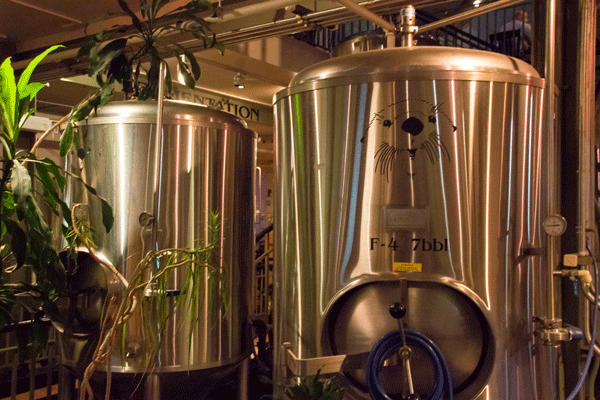
Almost 100 years before America would gain its independence, the Huguenot settlers of New Paltz practiced a local tradition still prominent today: copious beer drinking.
Around the turn of the 18th Century, not long after settlers first arrived in New Paltz, clean drinkable water was scarce and the cold of winter made grain and other food hard to find, prompting early residents to get many of their nutrients from beer and thus drink a lot of it, according to author, researcher and world-class beer drinker Craig Gravina.
Gravina recently completed a year-long project to learn about, and ultimately brew, the type of beer that was likely drank by the first Huguenot villagers. Historic Huguenot Street, Gravina and local brewery, The Gilded Otter, debuted the 1677 Huguenot Wheat ale with a keg tapping and tasting on the DuBois Fort Lawn on Aug. 29.
Darrien Currier, the brew master at The Gilded Otter, brewed a batch of this historic ale all of which has already been sold, drank and enjoyed. Currier said he plans to brew more, but there is not a timeline for the next batch as of yet.
Currier was first approached by Kara Gaffken, the director of public programming for Historic Huguenot Street last spring. After talking with Gravina about the availability of ingredients and the average alcohol by volume (ABV) level, he made the beer as close as he could to the original while still making it taste good, without an actual recipe.
He said that since wheat is high in protein, using too much of it would potentially clog or damage his equipment. After using as much wheat as he could, Currier supplemented the rest with barley, which was not as common in beer then as it is now. This beer was also sweeter, more of a full-body beer, because hops were also difficult to come by. However, the hops they did use back then were very similar to what Currier used called cluster hops.
“We’re pleased to introduce 1677 Huguenot Wheat to the public,” Gaffken said. “Darren and Craig are very knowledgeable about Hudson Valley brewing, and we know this historic ale will be both authentic and delicious. Partnering with a local business makes so much sense for New Paltz, and it reinforces our special, small-town feel.”
Gravina said local beer of that time was made with wheat because it was the crop that grew best in this area, noting that Esopus was a popular place to grow wheat; oats and rye were common base grains used as well. The beer was typically stronger (8, 9 or 10 percent ABV) than most beer drank today because a stronger brew stores more nutrients in less beer. The 1677 Huguenot Wheat came out at 8 percent.
“This was my first historic beer project,” Currier said. “I really enjoyed it because it allowed me to be creative instead of brewing the same beer I do all the time.”
Beer’s strength at that time was also not very consistent due to the fact that many people brewed at home, non-professionally. Even though there were brew houses, they did not have the scientific tools we have today to monitor and control the ABV, according to Gravina.
Gaffken said this project and event followed the Cider Market and Tasting to be the second historic food/drink event from Historic Huguenot Street. She said they will bring the Cider Market back next year and possibly even host a chocolate market, although there are no final plans for that yet.
